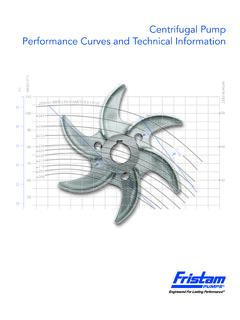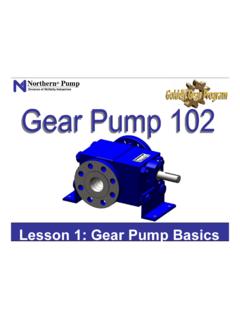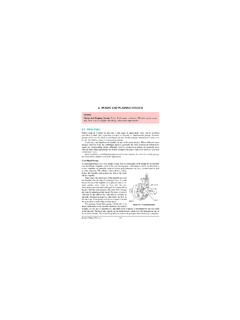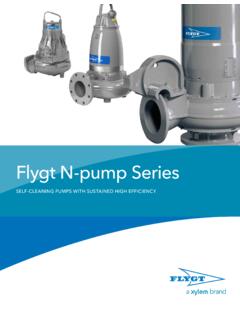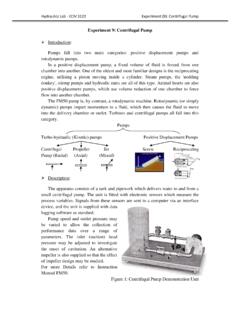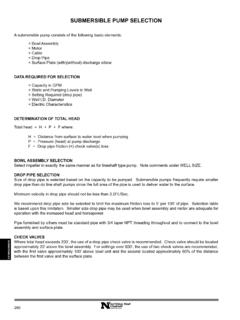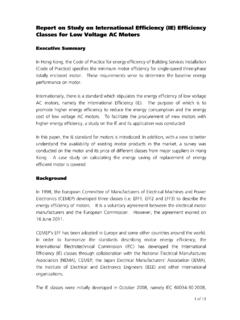Transcription of Positive Displacement Pump Basics - Fristam
1 Positive Displacement Pump BasicsA. Definitions and TermsDensityDensity is the mass of a substance per unit volume. Generally, we express density in units of pounds per cubic GravitySpecific gravity is used to compare the density of a product to the density of water. The specific gravity of a product is expressed as its density divided by the density of water. This number will have no units, because it is simply a called degrees Brix ( Brix), it is a hydrometer scale for sugar solutions. It is expressed as grams of soluble solids per 100g of liquid and is temperature corrected.
2 Sugar content is approximately proportional to the Brix value, with sugars contributing 55 to 75% of the Brix. ViscosityViscosity is a measurement of a product s resistance to flow. Low viscosity products ( water) have little resistance to flow, while higher viscosity products have a greater resistance to flow. It is key to Positive pump sizing and operation because it affects slip within the pump as well as the pressure required to over-come frictional loss in the lines. The product s resistance to flow produces system backpressure and heat.
3 It will be explained later that the increased resistance to flow can be seen in the relationship between the frictional pressure loss (psi / foot tubing), flow rate (gpm), and product viscosity (cps) in the pressure loss charts shown on pages 42-47. It will also be explained that this same resistance to flow, by higher viscosity products, can be seen in reduced product slip inside the pump. Newtonian vs. Non-Newtonian FluidsA Newtonian fluid will have the same viscosity whether or not it is in motion. Examples of this type of fluid would be water and high fructose corn syrup (HFCS).
4 A non-Newtonian fluid will have a different viscos-ity depending on the velocity of its flow. The majority of fluids are of this type, some examples would be ketchup, orange juice concentrate and FluidsA thixotropic fluid is a type of non-Newtonian fluid that will become less viscous as the shear rate increas-es. This is also known as shear thinning, ketchup is a good example of this type of fluid. While the product is static, or standing still, the viscosity can be very high. As the fluid begins to flow it becomes less viscous and starts to run like water.
5 After it sits again, it becomes very viscous. This thinning is due to shear in the fluid. As the fluid begins to move, the molecules will slide over each other and require less force to stay in motion. This force causes a shear stress in the fluid. Apparent ViscosityAs previously explained, non-Newtonian fluids have less viscosity in motion, than at rest. The viscosity of a product in motion is known as its apparent viscosity. When a non-Newtonian fluid is in motion the apparent viscosity should be used for calculating the pressure drop.
6 The apparent viscosity can be measured using a vis-cometer and plotting the results as a Viscosity vs. Shear Rate curve. This curve can be used with a shear rate curve for the tubing that is used in the system, to determine the apparent Find the prod-uct s flow rate (75 gpm) on the Flow Rate vs. Shear Rate curve for Draw a line to the right until it intersects the 3 tubing Follow the line down to find the shear rate. Shear rate=1254. Find the shear rate on the Vis-cosity vs. Shear Rate curve for the Move up until you intersect the Move left to find the apparent viscosity.
7 Apparent viscosity = 1500 Rate vs. Shear Rate050100150200250300050100150200250300 Shear Rate (1/s)Flow Rate (gpm)6"4"3" "2" "1"1231265000513 Rev AFigure 1 Viscosity vs. Shear Rate (Data Set 1) Rate, Sec-1 Apparent Viscosity, cps6541265000514 Rev AFigure 2 Atmospheric PressureAtmospheric pressure is the force exerted by the weight of the atmosphere. At sea level, the average atmo-spheric pressure is pounds per square inch (psia). Refer to Table 2 (page 48) for the average atmospheric pressure at different PressureGauge pressure is the pressure read on a gauge installed in a system.
8 At sea level the average atmospheric pressure is psia, this would be equal to 0 psi gauge pressure. This is measured in units of pounds per square inch gauge or PressureAbsolute pressure is calculated by adding the atmospheric pressure to the gauge pressure. This is measured in units of pounds per square inch absolute or Pressure (Head)Static pressure is the pressure exerted by a column of liquid above the centerline point of = (Z / ) x sg pz = static pressure (psia)Z = liquid level (ft)sg = specific gravity (product) = conversion factor (dimensionless)VacuumVacuum refers to a pressure that is below the normal atmo-spheric pressure.
9 If the tank feeding the inlet of a pump is at an absolute pressure less than atmospheric, the tank is said to be under vacuum. Vacuum is typically measured in units of inches of mercury (inches Hg). This number must be converted to psia, for NIPA calculations. For the conversion, see Table 6 on page PressureThe vapor pressure of a fluid is the pressure required at a given temperature to keep the fluid from turning to vapor. Water at 210 F has a vapor pressure of psia. See Table 1 for the water vapor pressure on page Net Inlet Pressure RequiredNIPR is the pressure required by a pump to perform smoothly without cavitating.
10 NIPR is measured in Net Inlet Pressure AvailableNIPA is the absolute pressure available at the inlet of the pump. NIPA is measured in PRESSURE( PSIG)= PSIA( PSIG)= PSIAAPPLIEDVACUUMPRESSUREAPPLIED(0 PSIG)= PSIA( PSIG)=0 PSIAABSOLUTEPRESSUREGAUGEPRESSURE 3FW "Figure 3 ZPz1265000474 Rev AFigure 4 CavitationCavitation is the formation of vapor bubbles due to insufficient pressure at the inlet of the pump. High product tempera-ture and/or low pressure on the inlet side of the pump can lead to insufficient pres-sure.
